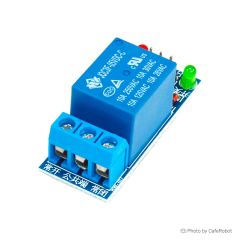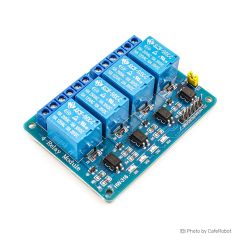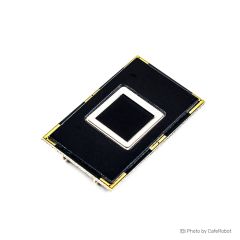ماژول تایمر رله قابل تنظیم 5-30 ولت 10 آمپر با رابط میکرو USB
- +25 5 % 94٬220 تومان
- +100 8 % 91٬630 تومان
- +300 10 % 89٬040 تومان
- +500 13 % 86٬450 تومان
- +1000 16 % 83٬860 تومان
ماژول تایمر رله 5-30 ولت با رابط میکرو USB و ترمینال لحیمکاری، یک ابزار ساده و قابل اعتماد برای کنترل و زمانبندی مدارهای قدرت است. این ماژول از گستره ولتاژ ورودی 5 تا 30 ولت پشتیبانی میکند و دو نوع رابط تغذیه (میکرو USB و ترمینال لحیم) دارد.
حالت کاری: پس از تأمین برق، پایههای ماژول در حالت پیشفرض قرار دارند: خروجی Normally Open (NO) از COM جدا است و Normally Closed (NC) به COM متصل است. با دریافت پالس پایین در ورودی تریگر (TRIG) یا فشار دادن دکمهی روی برد، رله عمل کرده و وضعیت خروجی تغییر میکند (NO به COM وصل، NC از COM قطع). پس از بازه زمانی تنظیمشده (پیشفرض 0 تا 24 ثانیه، قابل تنظیم با پتانسیومتر)، رله به حالت قبل بازمیگردد.
تنظیم زمان: زمان تاخیر با پتانسیومتر تنظیم میشود؛ مقدار پیشفرض 0–24 ثانیه است. در صورت نیاز به زمان طولانیتر میتوان خازن C2 را با مقدار بزرگتری جایگزین کرد یا پتانسیومتر مناسبتری نصب کرد. فرمول زمان حدودی: T = 1.1 × R × C (مثال: با C = 22µF و R = 1MΩ، T ≈ 24.2 ثانیه).
ویژگیها و حفاظتها: دارای LED نشانگر در زمان وصل شدن رله، حفاظت جریان پیوسته برای رله و طراحی ورودی سیگنال با مقاومت پول-آپ و فیلترینگ که توانایی بالایی در مقابله با تداخل الکترومغناطیسی دارد. این ماژول تحت شرایط تداخل هم عملکرد نادرست ندارد و مناسب کنترلهای صنعتی است.
مشخصات فنی ماژول
- ولتاژ کاری: 5–30 ولت
- رابط تغذیه: میکرو USB و ترمینال لحیمکاری
- حالت کاری: NO و NC طبق توضیح بالا (پیشفرض NO باز، NC بسته)
- زمان قابل تنظیم: پیشفرض 0–24 ثانیه (قابل افزایش با تغییر C2 یا پتانسیومتر)
- ظرفیت رله: قابل کنترل بار تا 10A (۱۰ آمپر) 250VAC یا 10A 30VDC
- محافظتها: حفاظت جریان پیوسته رله و حفاظت در برابر اتصال معکوس (در صورت نیاز)
- نشانگر: LED نشانگر وصل شدن رله
- ورودی سیگنال: دارای پول-آپ و مدار فیلترینگ برای مقاومت در برابر نویز
کاربردها
- تاخیر در هشدارهای ضد سرقت
- کنترل تأخیر روشن/خاموش سیستمهای روشنایی و صوتی ساختمان
- تاخیر در روشن شدن تجهیزات خودرو برای جلوگیری از ایجاد جریانهای اولیه زیاد
- راهاندازی ترتیبی دستگاهها برای جلوگیری از همزمانی مصرف بالای جریان
The 5–30V Trigger Delay Relay Timer Module with micro USB and solder terminal power interfaces is a reliable and simple solution for timing control in power circuits. It supports a wide input range of 5 to 30V and offers two power input options (micro USB and solder terminal).
Operating mode: After power is applied, the module's outputs default to: NO (Normally Open) disconnected from COM, and NC (Normally Closed) connected to COM. A low pulse on the trigger input (TRIG) or pressing the onboard button activates the relay: NO connects to COM and NC disconnects from COM. After the configured delay (default 0–24 seconds, adjustable with the potentiometer), the relay returns to its pre-trigger state.
Time adjustment: Delay time is set via the potentiometer; default range is 0–24 seconds. For longer delays, replace capacitor C2 with a larger value or use a higher-value potentiometer. Approximate timing formula: T = 1.1 × R × C (example: C = 22µF and R = 1MΩ → T ≈ 24.2 s).
Features and protections: Relay-on indicator LED, continuous-current protection for the relay, and a trigger input designed with pull-up and filtering circuitry to resist interference. The module is built to avoid false triggers even in noisy electromagnetic environments, making it suitable for industrial control.
Specification
- Working voltage: 5–30V
- Power interfaces: micro USB and solder terminal
- Working mode: NO and NC as described above (default NO open, NC closed)
- Adjustable time: default 0–24 seconds (extendable by changing C2 or potentiometer)
- Relay rating: up to 10A 250VAC or 10A 30VDC
- Protections: relay continuous-current protection and reverse-polarity protection if implemented
- Relay indicator: onboard LED
- Trigger input: pull-up and filtering for strong anti-interference performance
Applications
- Delay for anti-theft alarms
- Delayed control of building lighting and sound systems
- Delayed powering of vehicle equipment to prevent high inrush current
- Sequential startup of devices to avoid simultaneous high current draw




























